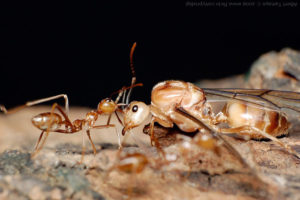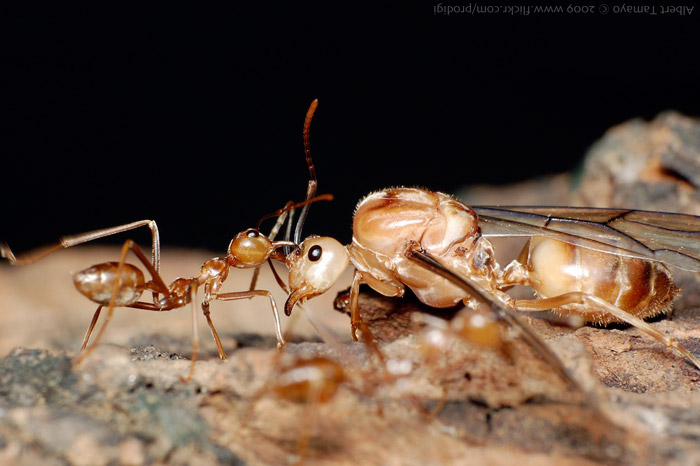Sit tight as we journey through another adventure in…
Ant Review (Part 2!):
Rise Of The Tree Dwelling Weaver Ants
By Ant Lover and Keeper, Elias Shaibani
Today, we will learn about an ant species that is quite famous for its ability to climb trees the size of skyscrapers (in relation to its size). Its homeland is southeast Asia. This species is a species very well-known to almost all people, though they may have never heard the key details about it.
It is none other than the Oecophylla or the Weaver Ant!

Fact bubble: Queens are useless for a colony; as all they do is mate and stay in the nest.
Description:
These ants are generally of a yellow-brown color, as the picture above shows. The workers are around 6 millimeters in size. The supermajors, the biggest antagonizer (pun intended) to all bugs in general Asia and the middle of Africa, are roughly 8-10 millimeters, and the monarchs are a whopping 20-25 millimeters. That’s almost 4 times as much as a normal average worker.

Fact Bubble: Weaver ant nests are made out of silk. More on this below.
Ant Comparison:
Now it is time to compare these ants with yet another ant ( and thus returns the infamous Lasius Flavus, who was the ant of the last issue).
This, however, will introduce a little ‘battle segment’!
As the weaver ants hear news of a new bug to scavenge off, they head their way to take their share!

Oecophylla (Weaver Ant):
Pros:
- They can live in trees that are easy to maintain; this means they don’t cost a lot.
- They usually farm aphids and only really need protein for the queen.
- These ants are an average size, so they won’t be too much to take care of.
- Standard practices for keeping these ants are usually unneeded, as they only tend to climb the tree.
Cons:
- These ants require a lot of temperature control if you do not live in Asia as these ants are very sensitive to the weather.
- These ants like to bend tree leaves, killing them unintentionally. This means you can’t use a tree you like very much…
- Ants of this genus are generally picky, like all ants, which means they will take weeks to move into a leaf for you to observe.
- Their larvae are the only way to make a new nest, so if the queen lacks protein, the colony will not be able to make more, thus causing the ants to die as the leaf dies.
As the yellow meadow ants also hear of a morsel to scavenge, they begin to prep up a line to conveyor-belt the food back to their nest.

Lasius Flavus (Yellow meadow ant):
Pros:
- Easy ant species to keep.
- Average size, meaning less chance of escape.
- Ants are generally shy, meaning no biting.
- Generally for the ant-keeper who is too busy.
Cons:
- Usually underwhelming.
- Tend to hide out during an attack, so only you can really defend them.
- Average size means that you don’t see them as well.
- In nature, they tend to milk and eat aphids. You can stop this by not having a plant though.
The Fight!
The two ants come to feast on what appears to be a dead cockroach. First contact is made when two ants unintentionally touch each other. Suddenly, the meadow ants begin to hurry to their nest, but the weaver ants follow, ready for a good snack. Some ants begin fighting outside, while nest workers block entrances. The weaver ants overpower the scout ants, and now head on to find an entrance. However, the last entrance is covered up, and the weaver ants return to the carcass to transport it.
Fun Facts:
- These ants are also called ‘orange gangsters’, ‘red ants’, ‘green tree ants’, ‘kerengga’, and ‘green ants’.
- These ants make nests by taking their young, who excrete silk, and rub it on specific places to make them stick to the leaf, thus making a nest.
- These ants are sometimes used as fish bait.
- These ants bites are very painful, as they spray formic acid with their bite.
- When making a nest, these ants have brace ants who hold the leaf together by biting one end down.
Ant Recap:
This species looks like a really fun and enjoyable ant. It will always amaze you and is fairly easy to take care of. You do, however, need a lot of space and tons of knowledge in order to give this colony a healthy life. This makes it for the ant keeper who can work at home, so they can pay full attention to it.


